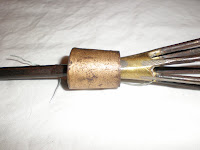
Here we have one of the last of my larger spear blades and spear components. I purchased this item via eBay (no surprises there) from a seller who believed it to be a knife or weapon of some sort. Although it superficially resembles some of the edged weapons from central Africa, the presence of a socket indicates this is a spear component of some sort. It is most likely a spear butt (a generally socketed spike or iron object serving as a counterweight to a heavy point). Where it's from, I don't know. My guess would be central Africa or Madagascar. The socket is narrow and it would only be suitable for a light spear.
The object is light, thin and somewhat flexible. It is decorated with faint lines along the middle of the blade. The blade (not really a blade, but corresponding to a blade) is not completely flat, but only faintly lens-shaped in cross section. Spear butts aren't expected to do a great deal, so I guess quality isn't paramount. The edges of the blade are roughly parallel for most of their length; in the last inch or so the edges flare out, giving the butt a spade or spatulate appearance. The socket is crude but functional, with a small hole (punched, not drilled) for a pin or rivet.
Overall, the point is crude yet functional. The blade is rusted and pitted, but the rust is not the flaky, scaly rust found on pieces made from modern steel. The point shows a great deal of use and "experience". The flared-out tips of the blade are bent (they could be straightened out, but carefully to prevent breaking them off). This is a nice, old used item that would make a nice display, but it certainly ain't the greatest piece I have.
Length (overall): About 10".
Length (blades/points): About 7 1/2".
Length (other dimensions): Socket is about 2 1/2".
Width at widest point (blade/point): About 2 1/2" if bent tips were repaired.
Width (other dimensions): Socket is about 5/8" wide.
Materials: Probably scrap iron.
If it is in fact Malagasy, it's a rare and desirable piece. Similar spear butts can be seenhere, here, and here (each from the American Museum of Natural History archives). These butts are much finer, but similar to the present item. It it's from the Congo, the value would be considerably less.


















































